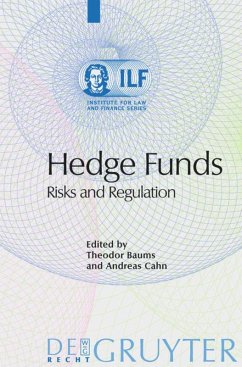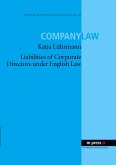The number of hedge funds and the assets they have under management has increased in recent years. This increase became significantly more pronounced after the market downturn in 2001. Hedge funds can help investors to benefit from volatile and even sinking stock markets. However, despite the prominent use of the word "hedge" in their name, such funds rarely offer a safe hedge against risk, given that they depend heavily on skill-based investment techniques and often invest in highly speculative financial instruments. Nevertheless, such funds received no specific treatment in the legislation of such major markets as Germany and the United States for years.
Against the backdrop of international regulatory concern for hedge funds, the Institute for Law and Finance (ILF), in cooperation with Deutsches Aktieninstitut e.V. (DAI), brought together leading scholars, lawyers and bankers, to assess the risks, opportunities and regulatory challenges that hedge funds present. At the time of the conference, German lawmakers were still discussing the need and possible content of a new law. The fruit of their discussions was the German Investment-Modernization Act (Investmentmodernisierungsgesetz), which entered into force on January 1, 2004, and increased the attractiveness of offering hedge fund products in the German market.
This inaugural volume of the Institute for Law and Finance Series contains the proceedings of the ILF/DAI May 2003 conference entitled "Hedge Funds: Risks and Regulation", and presents papers discussing the economic characteristics of and regulatory strategies for addressing hedge funds. The first two papers examine hedge funds from an economic perspective. Alexander M. Ineichen, Managing Director and Global Head of AIS Research at UBS, reveals the economic reality of hedge funds from the myths that has surrounded them. Then Franklin R. Edwards, Professor and Director of the Center for the Study of Futures Markets of the Columbia Business School in New York explains how the regulation of hedge funds should be tailored to their core economic reality and the goals of financial stability and investor protection. Next, Marcia L. MacHarg, a partner of Debevoise & Plimpton LLP, Ashley Kovas, a Manager in the Business Standards Department of the Financial Services Authority, London, and Edgar Wallach, a partner of Hengeler Mueller, present the state of the relevant regulatory structures in the United States, the United Kingdom, and Germany, respectively. The book then closes with an analysis of corporate structures used for German hedge funds, offered by Kai-Uwe Steck, a member of the German Asset Management practice group of Shearman & Sterling LLP.
[Hedge Funds. Risiken und Regulierung]Bei diesem Buch handelt es sich um den Einführungsband der Schriftenreihe des Institute for Law and Finance. Er enthält die Beiträgeder ILF/DAI-Konferenz, die im Mai 2003 unter dem Titel "Hedge Funds: Risiken und Regulierung" stattfand. Die Beiträge diskutieren die wirtschaftlichen Merkmale von Hedge Funds und Strategien der Regulierung vonFonds. Die ersten beiden Aufsätze untersuchen Hedge Funds aus ökonomischem Blickwinkel. Alexander M. Ineichen, Geschäftsführer und Leiter von AIS Research bei UBS, erläutert die ökonomische Realität von Hedge Funds frei von den Mythen, die sich um sie gerankt haben. Im Anschluss stellt Franklin R. Edwards, Professor und Direktor des Zentrums für das Studium von Zukunftsmärkten an der Columbia Business School in New York, dar, wie die Regulierung von Hedge Funds auf ihre ökonomische Kernrealität, die Ziele finanzieller Stabilität und des Schutzes der Investoren zugeschnitten sein müsste. Als nächste stellen Marcia L. MacHarg, Partnerin bei Debevoise & Plimpton LLP, Ashley Kovas, Manager in der Abteilung für Businessstandards der Finanzdienstleistungsbehörde in London, und Edgar Wallach, Partner von Hengeler Mueller, den Stand der relevanten Regulierungsstrukturen in den Vereinigten Staaten, in Großbritannien und in Deutschland vor. Das Buch schließt mit einer Analyse der Gesellschaftsstrukturen, die auf deutsche Hedge Funds angewendet werden, verfasst von Kai-Uwe Steck, einem Mitglied der German Asset Management practice group der Shearman & Sterling LLP.
Against the backdrop of international regulatory concern for hedge funds, the Institute for Law and Finance (ILF), in cooperation with Deutsches Aktieninstitut e.V. (DAI), brought together leading scholars, lawyers and bankers, to assess the risks, opportunities and regulatory challenges that hedge funds present. At the time of the conference, German lawmakers were still discussing the need and possible content of a new law. The fruit of their discussions was the German Investment-Modernization Act (Investmentmodernisierungsgesetz), which entered into force on January 1, 2004, and increased the attractiveness of offering hedge fund products in the German market.
This inaugural volume of the Institute for Law and Finance Series contains the proceedings of the ILF/DAI May 2003 conference entitled "Hedge Funds: Risks and Regulation", and presents papers discussing the economic characteristics of and regulatory strategies for addressing hedge funds. The first two papers examine hedge funds from an economic perspective. Alexander M. Ineichen, Managing Director and Global Head of AIS Research at UBS, reveals the economic reality of hedge funds from the myths that has surrounded them. Then Franklin R. Edwards, Professor and Director of the Center for the Study of Futures Markets of the Columbia Business School in New York explains how the regulation of hedge funds should be tailored to their core economic reality and the goals of financial stability and investor protection. Next, Marcia L. MacHarg, a partner of Debevoise & Plimpton LLP, Ashley Kovas, a Manager in the Business Standards Department of the Financial Services Authority, London, and Edgar Wallach, a partner of Hengeler Mueller, present the state of the relevant regulatory structures in the United States, the United Kingdom, and Germany, respectively. The book then closes with an analysis of corporate structures used for German hedge funds, offered by Kai-Uwe Steck, a member of the German Asset Management practice group of Shearman & Sterling LLP.
[Hedge Funds. Risiken und Regulierung]Bei diesem Buch handelt es sich um den Einführungsband der Schriftenreihe des Institute for Law and Finance. Er enthält die Beiträgeder ILF/DAI-Konferenz, die im Mai 2003 unter dem Titel "Hedge Funds: Risiken und Regulierung" stattfand. Die Beiträge diskutieren die wirtschaftlichen Merkmale von Hedge Funds und Strategien der Regulierung vonFonds. Die ersten beiden Aufsätze untersuchen Hedge Funds aus ökonomischem Blickwinkel. Alexander M. Ineichen, Geschäftsführer und Leiter von AIS Research bei UBS, erläutert die ökonomische Realität von Hedge Funds frei von den Mythen, die sich um sie gerankt haben. Im Anschluss stellt Franklin R. Edwards, Professor und Direktor des Zentrums für das Studium von Zukunftsmärkten an der Columbia Business School in New York, dar, wie die Regulierung von Hedge Funds auf ihre ökonomische Kernrealität, die Ziele finanzieller Stabilität und des Schutzes der Investoren zugeschnitten sein müsste. Als nächste stellen Marcia L. MacHarg, Partnerin bei Debevoise & Plimpton LLP, Ashley Kovas, Manager in der Abteilung für Businessstandards der Finanzdienstleistungsbehörde in London, und Edgar Wallach, Partner von Hengeler Mueller, den Stand der relevanten Regulierungsstrukturen in den Vereinigten Staaten, in Großbritannien und in Deutschland vor. Das Buch schließt mit einer Analyse der Gesellschaftsstrukturen, die auf deutsche Hedge Funds angewendet werden, verfasst von Kai-Uwe Steck, einem Mitglied der German Asset Management practice group der Shearman & Sterling LLP.








